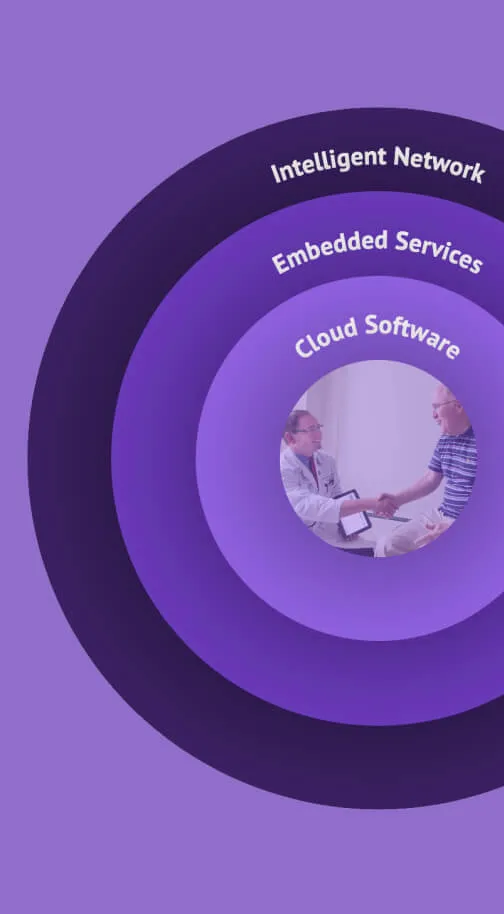Selecting the right healthcare IT solution
Running a medical practice—especially a small medical practice—is complex. There’s so much detailed work to do beyond caring for patients, and the administrative resources required for communicating with patients, negotiating with payers, and simply getting paid are enormous—it’s no wonder 63% of physicians report feeling overwhelmed by administrative burdens.1 Too often, that administrative burden ends up cutting into more important parts of your day—like spending time with patients. In fact, 68% of physicians report feeling rushed during patient interactions.2
How can you rebalance your time so you’re spending less on administrative work and more on the person-to-person interactions that lead to better experiences and outcomes for your patients? The answer may be right in front of you—your healthcare IT solution.
The right solution can help you build more efficient (and often, more automated) processes for your important, yet time-consuming administrative tasks, while simultaneously making your time with patients more productive.
Let’s explore how you can determine which healthcare IT solution is right for your small practice through the lens of five key criteria.
Evaluating your healthcare IT solution: 5 key criteria
Let’s look at some critical considerations that should factor into your choice.
1. Does it offer the right mix of solutions and services?
It’s simple: you’ll get the most value from your healthcare IT solution when you use it for many different things. Make a list of the functions you know you’ll need and try to find a solution that meets all critical needs. For example, for small practices, key technology solutions and support services include: an Electronic Health Records (EHR), practice management software, telehealth for virtual care, a patient portal or patient app, Revenue Cycle Management (RCM) services, medical billing and coding services, and consulting services for strategic guidance. Integrating all or a mix of these solutions can help drive more efficient operations, improve patient care, ensure compliance, and boost practice growth.
For instance, most practices participate in both fee-for-service and value-based quality reimbursement programs. Be sure to look for a solution that can help you perform well in both.
From a technical perspective, a solution that’s cloud based will provide cost savings up front because it won’t require additional hardware and IT resources. Cloud-based applications are also typically updated frequently and seamlessly, with no disruption to patients and staff.
2. Automation in the right places
Does your healthcare IT solution automate tasks to help you reduce documentation time and administrative tasks? In general, automation is most useful for common, recurring workflows where speed and accuracy are crucial—that is, administrative work.
Work with your team to determine what types of automation would be most beneficial to your practice and look for a healthcare IT solution that can deliver on your must-have capabilities.
3. Interoperability
Your healthcare IT solution’s ability to exchange information is one of its most important capabilities, creating big benefits for both you and your patients. When evaluating a solution, ensure that it is compatible with the network of labs, payers, healthcare providers, and any other important entities you commonly work with. Also make sure that the system you choose is capable of pulling in the right information at the right time, so you know you have the best and most current clinical information.
4. Ongoing support, training, and industry advocacy
It’s vitally important that the solution you choose is implemented strategically and skillfully. You should feel supported with proper training, documentation, and an accessible customer success team throughout the process.
However, support shouldn’t stop after a successful implementation. The right healthcare IT solution should have customer resources dedicated to your success, and incentivized to help you continue to get value. They should also be active at an industry-level, influencing the policies and regulations that will eventually impact your practice. Ideally, these customer enablement professionals will understand your unique needs not only from the size of your practice, but your specialty as well.
5. What is managed by you vs. what is managed by your healthcare IT solution?
At the end of the day, you want to be able to focus on what you do best––caring for patients. The software you choose should help you do that by managing as much of everything else as possible. Pick a healthcare IT solution that offers automated or support services (in addition to its core platform) that completely remove the most common administrative burdens from you and your team.
Now that we’ve listed which criteria to use when evaluating your healthcare IT solution, let’s take a look at why athenaOne is the right choice for those who want to ease administrative burden, drive efficiency, get paid easily, and get closer to patients.
The athenaOne all-in-one solution helps you manage many different parts of your practice more efficiently. And while efficiency is important––it’s far from the only benefit you’ll get.
What kinds of benefits does athenaOne provide?
Here are some of the most important benefits your practice should look for when considering healthcare IT solutions.
1. Clinical effectiveness
The most common challenges healthcare providers contend with revolve around the documentation process. How supportive or cumbersome your documentation workflows are can have a tremendous impact on your ability to be present with patients during encounters and determine how much work you’re taking home at the end of a day. Your solution should not only provide streamlined workflows that can be tailored to your specific specialty, but also supportive features like best-practice templates, macros, and other accelerators that help reduce your documentation time. athenaOne offers all of these tools plus the ability to document on the go, helping you significantly reduce or eliminate pajama time. And with athenaOne’s all-in-one solution, upgrades happen seamlessly, so it’s not necessary to manage your own IT stack—one less thing your small practice has to worry about.
2. Collect more of what’s owed, faster
Revenue cycle management (RCM) can be complex and time-consuming, but it’s critical to the success of every healthcare organization. Using the right RCM solution, healthcare organizations can maximize revenue, reduce administrative burden, optimize financial performance, and stay ahead of industry changes. athenaOne’s RCM capabilities help simplify revenue cycle work from the beginning stages at appointment scheduling, all the way to securing full payment. Proactive claims scrubbing, financial visibility, and benchmarking against similar organizations using athenaOne help empower practices to take control of their financial health, streamlining your revenue cycle and boosting your healthcare organization’s success. What’s more, our billing rules engine is designed to help catch costly errors before claim submission, and we work closely with payers to help ensure our customers get paid what’s owed.
3. Better care coordination
Experiential interoperability, being built to easily exchange information with other systems, is critical when it comes to choosing the right solution. Having access to current health records, along with connections to labs and other healthcare networks and systems, means you’re working with the best, most accurate picture possible of an individual’s health. athenaOne gives you a comprehensive view of your patient’s care history with an EHR that automatically incorporates data from across the healthcare ecosystem.
4. Empowered patients
The more your patients feel connected to you (and you to them), the stronger your practice will be. Patients should know they have easy access to their healthcare information and an open line of communication with their care provider. athenaOne empowers providers to enable a better patient experience and empowers patients with digital access to information and scheduling and payment tools that improve their experience while helping reduce staff work. With athenaOne, providers are the beneficiaries of learnings from our vast network, which in turn enables better practice outcomes related to everything from scheduling and payment tools to access to critical information. And better practice outcomes mean better patient outcomes.
Considerations for the future
In order to choose the right healthcare IT solution for your practice, keep an eye on key criteria like automation, interoperability, and customer support to help you make the right decision. Selecting the right solution for your small practice will deliver numerous benefits today and put you on the right path for the future. To get a healthcare IT solution that checks all of your boxes, learn more about how athenaOne is helping practices just like yours to succeed and grow.
- athenahealth, 2022, Physician Sentiment Survey; https://www.athenahealth.com/sites/default/files/media_docs/PSS2022.pdf; IS25
- Ibid.












